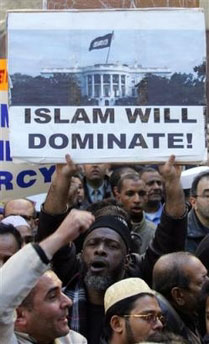The Truth about ISLAM (Part 5)

In light of the media coverage about the Roman Catholic pope's visit to Turkey...it is a great time to revisit facts about Islam:
The Origins of Islam
To understand Islam, you must understand the harsh circumstances into which the religion was born.
While Europe and much of the Middle East was transitioning from the Roman to the Byzantine Empire, with roads, irrigation canals, aqueducts, and a culture that included philosophical discourse and theater, the Arabians lived short and brutal lives in warring tribes with very little to offer the rest of the world beyond their own harsh existence.
The inhospitable climate protected the peninsula from conquest and cultural influence, although the Persians did manage to impose a written language on the coastal edges of the region that came to be known as Arabic. No foreign army felt that sheep and goats were worth taking from the desert fighters and the area was remarkably isolated. The renaissance of knowledge that the rest of the world had been experiencing since the Greek revival was largely missed out on by the Arabs, whose entire energies were devoted to daily survival against the ruthless environment and other tribes.
There were pagan traditions in Arabia, particularly among those based in the trading centers, such as Mecca and Medina. Kaaba, the black rock at Mecca, was worshipped by certain tribes with a circling ritual that was later borrowed by Muhammad’s followers. Likewise, Allah was the name that had been given to the moon god, many centuries before Muhammad's time.
Muhammad later created Islam based on these crude pagan practices as well as basic theological elements of Christianity and Judaism according to his own (often inaccurate) understanding. His erroneous interpretation of Christianity, for example, is often attributed to his early experiences with fringe cults in the Palestinian region.
Muhammad was born around 570 AD in Mecca. He grew up poor and orphaned on the margins of society, which was controlled by tribal chiefs and trading merchants. He worked for his uncle as a camel herder. Although his uncle had some standing in the community, Muhammad himself did not rise above his lowly station until he was 25, when he met and married a wealthy widow who was 15 years older.
Having now attained a comfortable lifestyle and the idle time that wealth affords, Muhammad would wander off occasionally for periods of meditation and contemplation. One day, at the age of 40, he told his wife that he had been visited by the angel Gabriel. Thus began a series of revelations which lasted until his death. The Qur’an is based on the oral traditions of these revelations. The Hadith is a collection of narrations of the life and deeds of Muhammad. The Sunnah is the said to be his way of life.
With his wife’s influence and support, Muhammad began trying to convert those around him to his new religion - an amalgamation of Judeo-Christian theology and pagan tradition that grew more sophisticated over time. In the beginning, he did his best to compromise his teachings with the predominant beliefs of the community’s elders, such as combining all 300 of their idols under the name “Allah,” although it wasn’t enough to prevent the resentment of the influential leadership, which mocked his humble background while fearing his influence (with good reason).
At first, he was only successful with friends and family. After twelve years, “the street preacher” could boast about 70 determined followers, called Muslims, who followed him to the community of Medina after they were chased from Mecca by persecution.
The Arab and Jewish tribes in Medina accepted Muhammad for the most part. Those that didn’t were gradually defeated in battle in a pattern that would quickly become the blueprint for the successful establishment of Islam as a world religion. Typically, the enemy’s trust would be gained by non-intrusive measures in which the Muslims would begin to insert themselves into the community while professing their respect for local traditions and political structures. As they began to gain power, however, they would divide loyalties and exercise violence to acquire local hegemony.
An example of this is the power gained over the Jews. At first, Muhammad preached that Christians and Jews could attain salvation through their own faith. This prompted their tolerance of him while he worked surreptitiously toward the power to dominate them. Since many rejected his status as a prophet (in the Old Testament tradition), Muhammad reneged on his earlier teachings and often had them killed when he finally had the power to do so.
After gaining control of Medina, Muhammad turned his attention back to Mecca. He directed his followers to raid Meccan caravans in the Holy months, when the victims would least expect it. Revelations were conveniently provided to him, which allowed his people to murder and steal in his service. The people around him gradually developed a lust for things that could be taken in battle, including material comforts and children. At one point, Muhammad even provided instructions on how women should be raped after capture.
Often the people captured in battle would be brought before the Prophet, where they would plead for their lives, arguing, for example, that they would never have treated the Muslims that way. The Hadiths are quite clear in portraying Muhammad as largely unmoved by their pleas, and ordering their deaths anyway, often by horrible means. In one case, he orders a man slain, telling him that “hell-fire” will take care of the poor fellow’s orphaned daughter.
Raids on caravans turned into military victories in which entire tribes were wiped out, their men executed and their women and children raped and enslaved under the Prophet’s direction. Some became Muhammad’s personal concubines, in addition to his fifteen wives. His personal life became a picture of hedonism and excess, all justified by frequent “revelations.” When he wanted a woman, even if she were the wife of another man or a child as young as 6, he was able to justify his lust and inevitable consummation with an appeal to Allah’s revealed will.
Though many of the Arab and Jewish tribes were eliminated and absorbed through military victory and forced conversion, the city of Mecca required a different sort of strategy. In 628, seven years after fleeing, Muhammad’s followers were allowed to reenter the city under an agreement whereby he set aside his title as “Prophet of Allah.” This was a temporary ploy that enabled him to gain a political foothold in the city through the same “fifth column” activities that are still used today by organizations such as the Council on American Islamic Relations (CAIR), which use their host’s language of religious tolerance to disguise ulterior motives.
Once Muhammad gained power through deceit in Mecca, he put anyone to death who would not submit. In what would be the model for future Muslim military conquests, those who would not convert to Islam were required to pay a tax (the Jizya) and accept third-class status.
For those who claim that Muslims were taught only to wage defensive battles against those who attack them, the life of Muhammad stands in stark contrast. One of the most notorious episodes was the well-documented attack against the peaceful farmers of Khaybar, merely because he wanted what they had. He even had one of the residents tortured to learn where the community's treasure was hidden. Muhammad then beheaded the man and "married" his widow.
Muhammad died of a fever at the age of 63, with his violent religion now firmly rooted in the Arab lands. Through his teachings, his followers viewed the worldly life as a constant physical battle between the Land of Peace (Dar al-Islam) and the House of War (Dar al-Harb).
Over the next fourteen centuries, the bloody legacy of this extraordinary individual would be a constant challenge to those living on the borders of the religion’s hegemony. The violence that Muslim armies would visit on people across North Africa, the Middle East, Europe and into Asia as far as India is a tribute to a founder who condoned subjugation, rape and murder in the cause of the spread of his religion.
It is certainly the basis not just for modern day terror campaigns against Western infidels (and Hindus and Buddhists) but also the broad apathy among Muslims across the world to the violence, which is an obvious enabler.
As Indonesian cleric, Abu Bakar Bashir recently put it, "If the West wants to have peace, then they have to accept Islamic rule."
Technorati:islam,Muslim,koran,Quran,Terrorism,islamophobia,islamic violence,mohammad,Muhammad,Iran
















